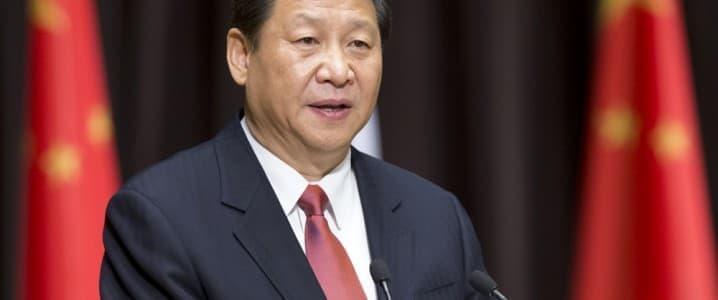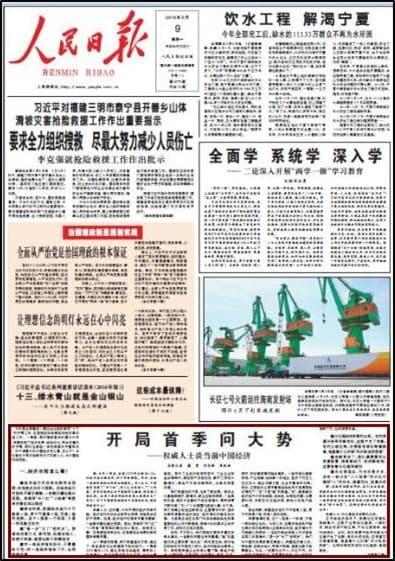Debt, Zombies, And Geopolitics: China’s Belt-And-Road Initiative During COVID
Tyler Durden
Thu, 10/01/2020 – 21:20
Authored by Jon (Yuan) Jiang via The Jamestown Foundation,
Introduction
The Belt and Road Initiative (BRI) has been a focal issue for understanding the foreign policy of the People’s Republic of China (PRC). Some observers view the BRI as representing a new phase of economic globalization and regional economic integration. Others argue that the BRI’s primary motivating factors are domestic and that the massive program is chiefly aimed at creating new markets, maintaining economic stability, resolving regional development imbalances, and transferring industrial overcapacity. Both views have their valid points, but overlook the BRI’s key role in supporting China’s domestic economic reforms. This article argues that the BRI should be understood as a major component of China’s program of “supply-side structural reform” (gongjice jiegouxing gaige).
The “Authoritative Person” and Supply-Side Structural Reform
The BRI was first announced in 2013 and officially incorporated into the PRC constitution in 2017 (Xinhua, October 24, 2017). The concept of “supply-side structural reform” (SSSR) was reportedly introduced by the Chinese Communist Party (CCP) General Secretary Xi Jinping in late 2015 and developed into a significant component of Beijing’s economic policy framework (Xinhua, April 3, 2018). In a speech to the 19th Party Congress, Xi stated that “We should pursue supply-side structural reform as our main task, and work hard for better quality, higher efficiency, and more robust drivers of economic growth through reform” (China Daily, December 18, 2019).
Throughout 2015 and 2016, the People’s Daily, the CCP’s most authoritative newspaper, published a series of interviews with an anonymous “authoritative person” (quanwei renshi) that discussed the concept of SSSR (People’s Daily, May 25, 2015; January 4, 2016; May 9, 2016). It has been widely understood that the information presented in this series of interviews came either from the offices of Liu He (??), director of the General Office of the Central Financial and Economic Affairs Commission (Zhongyang Caijing Weiyuanhui Bangongshi), or else from Liu himself. Liu is one of the PRC’s chief economic architects and has been described by party media as “one of the masterminds behind China’s supply-side structural reforms“ (People‘s Daily, March 20, 2018).
In the interviews, the “authoritative person” concluded that a return to China’s former debt-stimulated growth rate of ten-plus percent a year would be impossible, and instead stressed the sustainable and qualitative development of the Chinese economy. To this end, the main tasks of the SSSR are to improve the quality and efficiency of supply; promote structural adjustments; correct the allocation distortion of factors of production; enhance the adaptability and flexibility of the supply structure to changes in demand; and advance total factor productivity (People’s Daily, January 4, 2016). More concretely, SSSR encompasses five core policy objectives:
1) cutting excess industrial capacity;
2) reducing leverage in the corporate sector;
3) reducing property inventories;
4) lowering costs for businesses, and
5) addressing “weak links” in the economy (a euphemism for poverty reduction).
China’s BRI is well-positioned to address the first and fourth goals of SSSR. Hu Huaibang, former Chairman of the China Development Bank, has argued that the BRI can offset the problem of increasing labor costs through the structural transformation of China’s economy (People’s Daily, July 16, 2018). In this way, the BRI alleviates industrial overcapacity by transferring low-end manufacturing industries to less developed countries with lower labor costs.
SSSR and China’s Persistent Problem of Corporate Debt
The most crucial objective of SSSR is reducing leverage in the corporate sector. At the 2017 National Financial Work Conference, Xi stated that “financial stability is the basis of national stability, and deleveraging state-owned enterprises is the top of the top priorities. ” Xi called on local officials to control debt and maintain social security, while declaring local government debt to be one of the greatest threats to China’s financial security (Xinhua, July 15, 2017). At the end of 2019, the global financial rating companies Moody’s Analytics and Fitch Ratings, Inc. both raised warnings about rising defaults in Chinese debt. Moody’s chief economist warned that Chinese corporate debt represented the “biggest threat” to the global economy (Business Times (China), December 18, 2019).
Presciently, the “authoritative person” had warned two years earlier that the leverage issue, rather than unemployment, could cause disasters for China:
The total labor force in China is decreasing year by year…Even if the economy is experiencing a significant downturn, social employment can remain generally stable… However, the issue of leverage is different… High leverage will inevitably bring high risks. Poor control over leverage will lead to a systemic financial crisis [and] negative economic growth, even causing ordinary people to lose their savings. This will be disastrous. (People’s Daily, May 9, 2016).
Ma Guonan, a fellow at the Mercator Institute for China Studies, has found that China has had the fastest-growing ratio of corporate debt to GDP of any country in the world, rising by 65 percent following the 2008 global financial crisis. Ma’s calculations found that China’s total corporate, government, and household debt had doubled in ten years to a high of roughly 242 percent of total GDP, making China “the most indebted emerging economy” (MERICS, August 22, 2019).
A 2019 OECD working paper found that China’s corporate debt was concerningly high, with state-owned enterprises (SOEs) accounting for over three-quarters of that debt in 2017 (OECD, February 7, 2019). A 2016 article in People’s Daily by Liu Yuanchun , Vice President of Renmin University, argued that SSSR should center on SOE reforms. Liu’s article was designated “essential reading” (renmin yaolun), again hinting at strong official support for controlling the risk of overleveraged SOEs (People’s Daily, February 25, 2016).
The Belt and Road Initiative’s Role in Supply-Side Structural Reform
Because of the BRI’s close association with the Chinese government, the program has mostly benefited SOEs, which have both the funding and connections to successfully lobby for contracts (Daily Economic News (China), September 20, 2018). In 2018, People’s Daily reported that central government-run SOEs had undertaken 3,116 BRI projects, with data from the State-owned Assets Supervision and Administration Commission of the State Council (Guowuyuan Guoyou Zichan Jiandu Guanli Weiyuanhui) (SASAC) showing that central SOEs were contracted on half of all current and planned future infrastructure projects related to the BRI (China Daily, November 12, 2018).
PRC officials are looking to the BRI to help SOEs address the overcapacity problem, open up external markets, and offset rising domestic labor costs. BRI participation can also help SOEs carry out the SSSR-mandated goal of controlling corporate debt. As stated by Hong Shen of Carnegie Mellon University, “Many BRI projects are directly funded by Beijing-backed financial institutions that often explicitly or implicitly require receiving countries to outsource projects to Chinese companies.” Such project demands create a captive market for SOEs, providing an opportunity to pay down their over-leveraged debt.
Despite its benefits, the external risks associated with the BRI may still be too much to bear for Chinese SOEs. In the last year, Beijing has invested less in the BRI, and the dream of creating a win-win network of “enhanced economic interconnectivity” has had limited effect in mitigating economic crises such as the U.S.-China trade war or the global pandemic (China Brief, September 26, 2019; November 1, 2019; March 16). In the wake of new foreign hostilities, and a slowing global economy exacerbated by the ongoing COVID-19 pandemic, the CCP leadership has ramped up efforts to reduce China’s reliance on overseas markets and technology to drive economic growth. This drive has culminated in Xi Jinping’s recent push for a new “dual circulation” (shuangxunhuan) economic model (China Brief, August 14, 2020; Asia Times, August 24; Xinhua, September 2).
Image: Front page of the May 9, 2016 issue of People’s Daily, featuring an article by an unnamed “authoritative person” on China’s economic reforms. (Image source: Sina.com)
In giving Chinese SOEs unprecedented access to overseas contracts, the BRI seemed well-positioned to aid debt reduction and job creation, two key issues for ensuring China’s economic survivability. But the BRI may have also revealed a grim truth: that China’s SOEs have difficulty competing in both domestic and overseas markets, even with the assistance of the Chinese government and the BRI. China’s SOEs are popularly called “zombie enterprises” because they rely on government subsidies or bank loans to stay alive (China Brief, March 16), a fact noted by the “authoritative person.” As a result, one of the most urgent tasks of the Chinese government is to deal with these “zombies” in order to reduce excessive production capacity, and free up valuable physical resources, credit resources, and market space (People’s Daily, January 4, 2016).
From 2016 to 2019, the state-owned steel giants Dongbei Special Steel, Chongqing Iron & Steel, Henan Commerce & Trade, and Bohai Steel were either liquidated or went bankrupt. In 2019, Beijing issued a reform plan to speed up the improvement of the SOE exit system, promoting the bankruptcy and restructuring of state-owned zombies (Guancha, July 16, 2019). These concrete measures have had tangible results: SOE debt growth has declined since 2017 (OECD, February 7, 2019). A recent article by Guo Shuqing, Secretary of the Party Committee of the People’s Bank of China and Chairman of the China Banking and Insurance Regulatory Commission, also confirmed that the corporate sector’s leverage ratio has stabilized and declined (Qiushi, August 16).
Conclusion: SSSR and the BRI after COVID-19
The Rhodium Group has projected that Beijing can retain the high gear lending of the BRI because policy banks are able to maintain the loan pace of 2015-2019 (Rhodium Group, April 15). BRI loans form a minor part of the Chinese overall lending portfolio, and China Development Bank and China Export-Import Bank have ample political support to cover the cost. But Beijing is unlikely to enlarge its loans to BRI-participating countries in the short term. Due to the pandemic, some states may not be able to make their repayments on time, and the BRI may face financial losses. A June report by the Ministry of Foreign Affairs noted that COVID-19 had “seriously affected” nearly a fifth of projects along the BRI (SCMP, June 28). Beijing may either opt to reduce debt obligations or seek to postpone payments and extend terms, as sovereign lenders often do in response to a financial crisis. Renegotiating the terms of BRI-related debt will bring its own political and economic risks, and could raise the specter of debt-trap diplomacy, hurting China’s international prestige. Postponing payments would also increase the financial sector’s total debt, undermining the principles of SSSR.
Fortunately, after several years of implementation, the ambiguously defined and constantly evolving BRI has shown its versatility and adaptability. In the aftermath of COVID-19, the PRC has promoted once-overlooked concepts such as the Digital Silk Road and the Health Silk Road to spur global economic recovery, as well as emphasizing “green” aspects of the BRI that parallel China’s leading role in international climate change dialogues (IIGF (Beijing), May 30). China’s leadership is also reframing the BRI to align with high-level policies to deleverage and carry out SSSR. In a speech at the Second Belt and Road Forum for International Cooperation in 2019, President Xi Jinping said “we welcome the participation of multilateral and national financial institutions in BRI investment and financing and encourage third-market cooperation” (PRC Ministry of Foreign Affairs, April 26, 2019).
Recent testimony to the Chinese People’s Political Consultative Conference (CPPCC) has also underscored Xi’s claim that future funding for the BRI will no longer prioritize SOEs, instead opening up the playing field to private actors and foreign companies. (China-U.S. Focus, July 30). State media organs and leading economists have effectively disavowed China’s bloated “zombie” SOEs, leaving room for developments towards a multi-tiered, market-oriented financing system that will better support China’s domestic prioritization of SSSR.
via ZeroHedge News https://ift.tt/3ijLZt1 Tyler Durden

